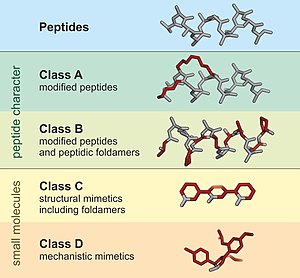
A peptidomimetic is a small protein-like chain designed to mimic a peptide.[1][2] They typically arise either from modification of an existing peptide, or by designing similar systems that mimic peptides, such as peptoids and β-peptides. Irrespective of the approach, the altered chemical structure is designed to advantageously adjust the molecular properties such as stability or biological activity. This can have a role in the development of drug-like compounds from existing peptides. Peptidomimetics can be prepared by cyclization of linear peptides or coupling of stable unnatural amino acids.[3] These modifications involve changes to the peptide that will not occur naturally (such as altered backbones and the incorporation of nonnatural amino acids). Unnatural amino acids can be generated from their native analogs via modifications such as amine alkylation, side chain substitution, structural bond extension cyclization, and isosteric replacements within the amino acid backbone.[3] Based on their similarity with the precursor peptide, peptidomimetics can be grouped into four classes (A – D) where A features the most and D the least similarities. Classes A and B involve peptide-like scaffolds, while classes C and D include small molecules (Figure 1).[1]
- ^ a b c Pelay-Gimeno M, Glas A, Koch O, Grossmann TN (July 2015). "Structure-Based Design of Inhibitors of Protein-Protein Interactions: Mimicking Peptide Binding Epitopes". Angewandte Chemie. 54 (31): 8896–927. doi:10.1002/anie.201412070. PMC 4557054. PMID 26119925.
- ^ Marshall GR, Ballante F (September 2017). "Limiting Assumptions in the Design of Peptidomimetics". Drug Development Research. 78 (6): 245–267. doi:10.1002/ddr.21406. PMID 28875546. S2CID 5730986.
- ^ a b Avan, Ilker; Hall, C. Dennis; Katritzky, Alan R. (22 April 2014). "Peptidomimetics via modifications of amino acids and peptide bonds". Chemical Society Reviews. 43 (10): 3575–3594. doi:10.1039/C3CS60384A. PMID 24626261.